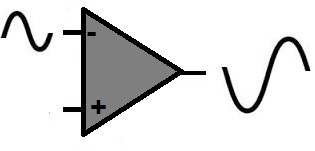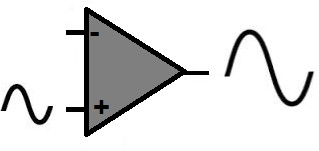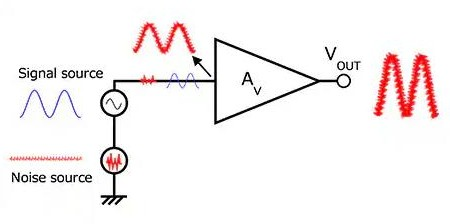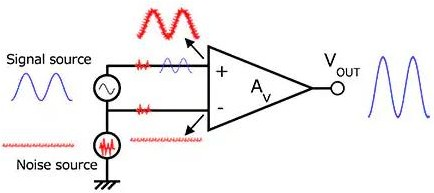Overview
Operational amplifiers, often abbreviated as op-amps, are versatile and widely used integrated circuits in the field of electronics. They play a crucial role in a wide range of applications, from signal processing and audio amplification to instrumentation and control systems. This article delves into the intricacies of operational amplifiers, exploring their functions, characteristics, and applications.
Functions of Operational Amplifiers

Figure 2 Operational Amplifier Circuit
An operational amplifier is a high-gain, differential voltage amplifier with two input terminals (inverting and non-inverting) and a single output terminal. Its primary function is to amplify the voltage difference between its inputs, producing an output voltage that is a multiple of this difference. Op amps exhibit characteristics such as high input impedance, low output impedance, and a near-infinite open-loop gain.
These characteristics make them invaluable for various tasks, including voltage amplification, signal filtering, waveform generation, and mathematical operations. Op-amps are also commonly used in feedback configurations to create stable amplifier circuits with desired gain and characteristics.
Operational Amplifier Configurations
Diving into Different Ways Operational Amplifiers Work: Maling Complex Concepts Clear
Operational amplifiers (op-amps) might sound fancy, but they're like versatile helpers in electronics. Imagine them as tools that can do different jobs, depending on how you use them. Let's break down these jobs in simple terms so you can get a grasp of what they do and where you might see them.
Op-amps can be configured in different ways to achieve specific functions:
1. Inverting Amplifier:
In this configuration, the input signal is applied to the inverting input terminal, and the output is the inverted and amplified version of the input signal.
Think of the inverting amplifier as a signal flipper. You put a signal in, and it comes out flipped (like a mirror image) and bigger. Imagine it as a magic mirror that takes your words and makes them louder and backwards.

Figure 3 Inverting Amplifier
2. Non-Inverting Amplifier:
Here, the input signal is applied to the non-inverting input terminal, and the output is a scaled, non-inverted version of the input signal. Now, the non-inverting amplifier is more like a signal booster. It takes your input, makes it louder, but doesn't change its direction. It's like when you're telling a story, and your friend listens attentively, nodding along, without changing your words.

Figure 4 Non Inverting Amplifier
3. Differential Amplifier:
This configuration amplifies the voltage difference between two input signals. It is commonly used in applications that require signal amplification while rejecting common- mode noise. Think of the differential amplifier as a noise filter. It listens to two sounds and only pays attention to the difference between them. So, if there's a lot of background noise, it kind of ignores it and only focuses on the important part of the story.

Fig a: Single Ended Amplifier

Fig b: Differential Amplifier
4. Summing Amplifier:
A summing amplifier produces an output that is the weighted sum of multiple input signals. It's useful for applications like audio mixing. Imagine the summing amplifier as a mixer at a party. It takes different music from various sources and combines them to create a new mix. So, if you have your favorite songs playing from different speakers, the summing amplifier helps blend them together for everyone to enjoy.

Figure 5 Summing Amp Circuit and waveforms
5. Integrator and Differentiator:
By incorporating capacitors and stm32h753xih6 -4813125> resistors , op amps can be configured as integrators (producing an output that's the integral of the input) or differentiators (producing an output that's the derivative of the input).
An integrator is like a calculator that adds up numbers over time. So, if you're counting how many steps you take each day, the integrator would keep track of the total steps.
A differentiator, on the other hand, is like a speedometer in your car. It tells you how fast you're changing your speed. If you suddenly hit the gas pedal and speed up, the differentiator would notice that quick change.
So, Why Does It Matter?
Imagine you're building something cool, like a music system or a robot. Each of these op amp "jobs" is like a special tool you can use to make your creation work just the way you want it to. By understanding how op-amps can be used differently, you have the power to design all sorts of amazing gadgets and machines!
Operational Amplifier Applications (Practical Uses of Operational Amplifiers: Making Sense of Real-World Applications)
Operational amplifiers (op-amps) might sound technical, but they're pretty cool tools that have real-life jobs. Imagine op-amps as helpers with specific tasks, just like people in different professions. Let's explore these tasks in simpler terms so you can see where op-amps show up and why they matter.
Operational amplifiers find applications in various fields:
- AudioAmplification: Op-amps are employed in audio equipment for amplifying weak audio signals from sources such as microphones, musical instruments, and CD Op amps are like the sound boosters in your music player. They take weak sounds from things like microphones, musical instruments, or CD players, and make them loud enough for you to hear. Think of them as the backstage crew that makes sure every note in a concert reaches your ears.
- SignalProcessing: They are used for filtering out unwanted frequencies, smoothing signals, and adjusting signal levels. Imagine op-amps as filters for your signals, like sorting out the important parts of a story. They help get rid of unwanted parts of a signal, make it smoother, or change its level. Think of op-amps as signal magicians that make sure only the clearest parts of a message come through.
- Instrumentation:Op-amps are the backbone of precision measurement instruments, such as digital multimeters and Op-amps are the superheroes of measurement tools, like the meters and scopes in a science lab. They ensure the measurements are super accurate and reliable. Think of them as the lab assistants that help scientists gather precise data for their experiments.
- FeedbackControl Systems: They are integral to creating stable control systems for tasks like temperature regulation, motor speed control, and robotics. Think of op-amps as the traffic controllers in a busy They keep things running smoothly by making sure cars (or in this case, systems) follow the right rules. Op-amps help regulate things like temperature, motor speed, and even robots, so everything stays under control.
- AnalogComputing: Op-amps were historically used in analog computers for solving mathematical equations through electrical circuitry. Back in the day, op-amps were like the brainy calculators in old-fashioned computers. They helped solve complicated math problems using electric circuits. Think of them as the math whizzes that worked out equations without using screens or keyboards.
Why Should You Care?
Imagine you're building something amazing, like a music player that sounds fantastic or a robot that moves just right. Op-amps are like the special ingredients that make your creation work perfectly. By understanding how op-amps fit into these different jobs, you can design all sorts of cool things that make life better and more fun!









